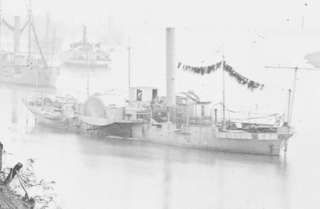USS A. Houghton – a 326 ton bark – was purchased during the beginning of the American Civil War by the Union Navy.

USS Hartford, a sloop-of-war steamer, was the first ship of the United States Navy named for Hartford, the capital of Connecticut. Hartford served in several prominent campaigns in the American Civil War as the flagship of David G. Farragut, most notably the Battle of Mobile Bay in 1864. She survived until 1956, when she sank awaiting restoration at Norfolk, Virginia.

The first USS Miami was a side-wheel steamer, double-ender gunboat in the United States Navy during the American Civil War.

USS Sciota was a Unadilla-class gunboat built on behalf of the United States Navy for service during the Civil War. She was outfitted as a gunboat, with both a 20-pounder rifle for horizontal firing, and two howitzers for shore bombardment, and assigned to the Union blockade of the waterways of the Confederate States of America.
USS Henry Janes was a mortar schooner acquired by the United States Navy during the American Civil War. She was used as a gunboat and assigned to the blockade of ports of the Confederate States of America.

USS Owasco was a Unadilla-class gunboat built for the Union Navy during the American Civil War. She was named for Owasco Lake.
The second United States Navy vessel to bear the name, USS Sachem was a screw steamer built in 1844 at New York City, where the U.S. Navy purchased her on 20 September 1861.
The second USS Kensington was a steamship in the United States Navy.
USS Horace Beals was a barkentine acquired by the Union Navy during the American Civil War. She was placed into service as a cargo ship assigned to support the fleet blockading the ports of the Confederate States of America. However, at times, Horace Beals was assigned extra tasks, such as that of a hospital ship as well as an ammunition ship.

USS Racer was a schooner acquired by the Union Navy during the American Civil War. She was used for various purposes, but, especially for bombardment because of her large 13-inch mortar that could fire up and over tall riverbanks.
USS John Griffith was a mortar schooner acquired by the Union Navy during the American Civil War. She was used for various purposes, but especially for bombardment because of her large 13-inch mortar and 12-pounder howitzers that could fire up and over tall defensive riverbanks.
USS Orvetta was a schooner acquired by the Union Navy during the American Civil War. She was used by the Navy to patrol navigable waterways of the Confederacy to prevent the South from trading with other countries.
USS Matthew Vassar was a schooner purchased by the Union Navy during the American Civil War. She was used by the Union Navy primarily as a mortar gunboat, but also as a gunboat stationed off Confederate ports to prevent their trading with foreign countries.
USS Sea Foam was a brig purchased by the Union Navy during the American Civil War.
USS Adolph Hugel was a schooner acquired by the Union Navy during the American Civil War.
USS George Mangham was a schooner acquired by the Union Navy during the American Civil War. She was used by the Union Navy as a gunboat in support of the Union Navy blockade of Confederate waterways.
USS Arletta was a schooner acquired by the Union Navy during the American Civil War. She was used by the Union Navy as a gunboat and, at times, an ammunition ship, in support of the Union Navy blockade of Confederate waterways.
USS Norfolk Packet was a large schooner purchased by the Union Navy during the American Civil War. She was assigned to gunboat duty in the inland waterways of the Confederate States of America.
USS Sidney C. Jones was a schooner that served in the Union Navy during the American Civil War. Built in East Haddam, Connecticut, and launched in April 1856, Sidney C. Jones was intended to be used on trade routes. In October 1861, she was purchased by the Union Navy for military service. Originally intended for service on the Union blockade, she was later converted into a mortar schooner and was armed with a mortar and four other cannons. In April 1862, she participated in the bombardment of Confederate positions at Fort Jackson and Fort St. Philip. During July, she ran aground while part of a force bombarding Vicksburg, Mississippi, and was blown up by her crew to prevent capture on July 15.
USS T. A. Ward was a 284-ton schooner was purchased by the Union Navy during the Union blockade of the Confederate States of America during the American Civil War.



